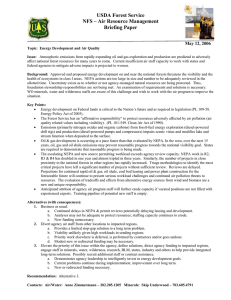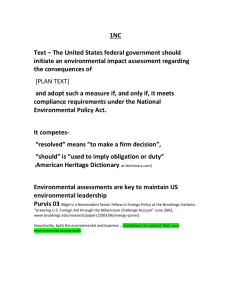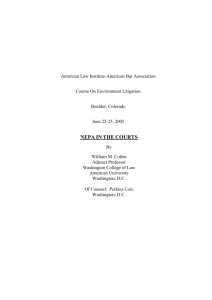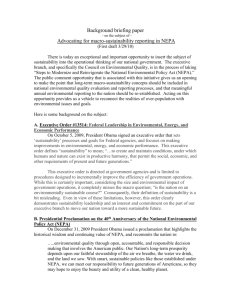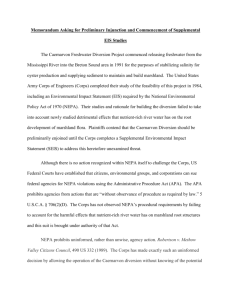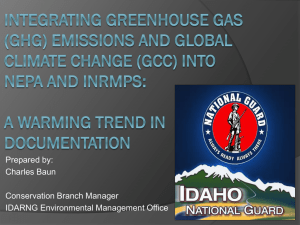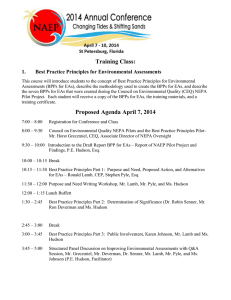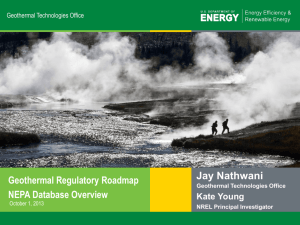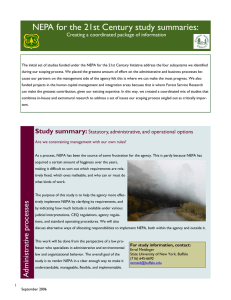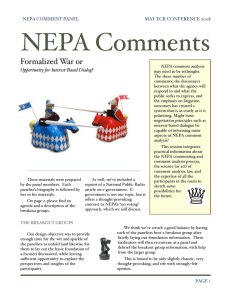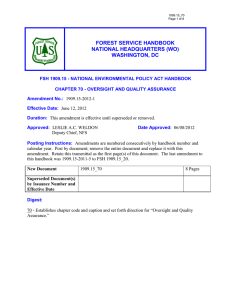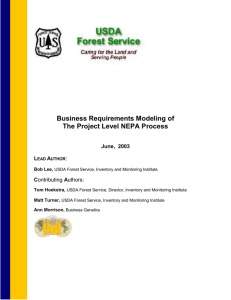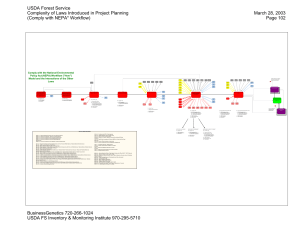Legal Sufficiency Considerations
advertisement
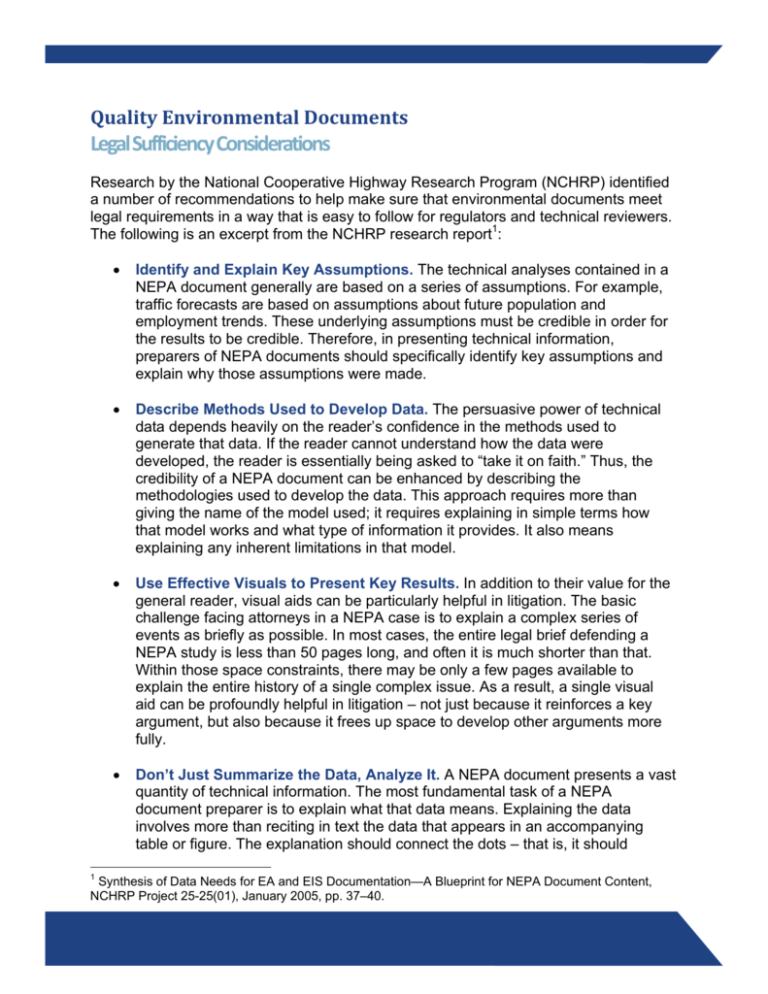
QualityEnvironmentalDocuments Legal Sufficiency Considerations Research by the National Cooperative Highway Research Program (NCHRP) identified a number of recommendations to help make sure that environmental documents meet legal requirements in a way that is easy to follow for regulators and technical reviewers. The following is an excerpt from the NCHRP research report1: 1 Identify and Explain Key Assumptions. The technical analyses contained in a NEPA document generally are based on a series of assumptions. For example, traffic forecasts are based on assumptions about future population and employment trends. These underlying assumptions must be credible in order for the results to be credible. Therefore, in presenting technical information, preparers of NEPA documents should specifically identify key assumptions and explain why those assumptions were made. Describe Methods Used to Develop Data. The persuasive power of technical data depends heavily on the reader’s confidence in the methods used to generate that data. If the reader cannot understand how the data were developed, the reader is essentially being asked to “take it on faith.” Thus, the credibility of a NEPA document can be enhanced by describing the methodologies used to develop the data. This approach requires more than giving the name of the model used; it requires explaining in simple terms how that model works and what type of information it provides. It also means explaining any inherent limitations in that model. Use Effective Visuals to Present Key Results. In addition to their value for the general reader, visual aids can be particularly helpful in litigation. The basic challenge facing attorneys in a NEPA case is to explain a complex series of events as briefly as possible. In most cases, the entire legal brief defending a NEPA study is less than 50 pages long, and often it is much shorter than that. Within those space constraints, there may be only a few pages available to explain the entire history of a single complex issue. As a result, a single visual aid can be profoundly helpful in litigation – not just because it reinforces a key argument, but also because it frees up space to develop other arguments more fully. Don’t Just Summarize the Data, Analyze It. A NEPA document presents a vast quantity of technical information. The most fundamental task of a NEPA document preparer is to explain what that data means. Explaining the data involves more than reciting in text the data that appears in an accompanying table or figure. The explanation should connect the dots – that is, it should Synthesis of Data Needs for EA and EIS Documentation—A Blueprint for NEPA Document Content, NCHRP Project 25-25(01), January 2005, pp. 37–40. identify patterns in the data, explain causal relationships, and explain anomalous or otherwise unexpected results. The data rarely speaks for itself; the responsibility for explaining the data rests with the preparer of the NEPA document. Document Compliance with Key Regulatory Requirements. The NEPA process is typically used as the vehicle for achieving compliance not only with NEPA, but also with a range of other laws, including Section 7 of the Endangered Species Act, Section 106 of the National Historic Preservation Act, Section 4(f) of the Department of Transportation Act, Section 404 of the Clean Water Act, and air quality conformity requirements under Section 176(c) of the Clean Air Act. These regulatory requirements often are the subject of legal disputes. Given the potential for disputes, it is prudent for a NEPA document to include a systematic, point-by-point review of these regulatory requirements – explaining which are applicable, which are not applicable, and how the applicable requirements have been met. This overview of regulatory compliance may have limited value for the general reader, but has great value for a reviewing court. Provide Overview of Major Project Issues. In most NEPA studies, there are a few issues that receive a disproportionate amount of attention from regulatory agencies, interest groups, or the public. These issues often involve long-running efforts to resolve complex or controversial issues. By the time the NEPA process is completed, the issue may have generated hundreds of pages of technical studies, dozens of letters among agency officials, and hundreds of public comments. For permitting agencies or a reviewing court, it can be difficult to assess the lead agency’s handling of such a complex issue. The NEPA document can greatly facilitate the task of agency reviewers and the courts by listing these major issues and briefly explaining the concerns that were raised and how those concerns were addressed. This summary should provide crossreferences to other locations in the document where more detail is provided. Systematically Review Data to Ensure Internal Consistency. The large amount of data presented in a NEPA document creates numerous opportunities for internal inconsistencies and contradictions. There may be inconsistencies in a single section between the tables and the text; there may be inconsistencies between discussions of the same issue in different sections; and there may be inconsistencies between discussions of different issues that happen to involve the same data (e.g., traffic, noise, and air quality). There is no simple or easy way to eliminate these inconsistencies; cross-checking is an inherently timeconsuming and onerous task. Nonetheless, careful cross-checking to ensure rigorous consistency is a valuable effort that enhances the credibility of the document for the public, agency reviewers, and a reviewing court. Following these recommendations will help to make NEPA documents more readily understandable by the general public, while at the same time helping to demonstrate for agency reviewers and the courts that all applicable legal requirements have been met.

